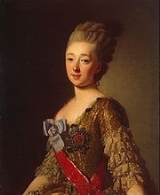
Natalia Alexeievna of Russia
Encyclopedia
The Grand Duchess Natalia Alexeievna of Russia (25 June 1755 – 15 April 1776) was the first wife of the future Tsar Paul I of Russia
, the only son of the Empress Catherine II. She was born as Princess Wilhelmina Louisa of Hesse-Darmstadt in Prenzlau
, Uckermark
, Brandenburg
, Prussia
as the fifth child of Ludwig IX, Landgrave of Hesse-Darmstadt and his spouse Caroline of Zweibrücken.
for "recommendations". The King thought about the remaining three unmarried daughters of the Landgravine of Hesse-Darmstadt. Unable to decide which one was worthy, the Empress sent an invitation to Wilhelmine, her sisters Amalie
and Louise, and their mother to visit Russia. Hurriedly, the three Princesses studied to perfect their French, worked on their dancing, practiced dropping deep curtseys, and completed their wardrobes. Their first stop was in Berlin where from there a flotilla of four ships, sent by the Empress Catherine, took them to Russia. It was the Grand Duke Paul's best friend, young Andrei Razumovsky, who commanded the frigate that carried the young ladies and their mother. He was immediately captivated by these charming passengers, and was particularly taken with Wilhelmine. She was not insensible to the admiration of Andrei.
Two days after arriving in Russia, the Grand Duke Paul chose Wilhelmine to be his wife. Wilhelmine was very pretty, gay and exuberant, and Paul was very delighted with her. Their betrothal was celebrated with great ostentation and Wilhelmine changed her religion and her given name: she became Natalia Alexeievna. On 29 September 1773, the wedding took place in the church of the Nativity of the Mother of God.
Paul I of Russia
Paul I was the Emperor of Russia between 1796 and 1801. He also was the 72nd Prince and Grand Master of the Order of Malta .-Childhood:...
, the only son of the Empress Catherine II. She was born as Princess Wilhelmina Louisa of Hesse-Darmstadt in Prenzlau
Prenzlau
Prenzlau , a city in the Uckermark District of Brandenburg in Germany, had a population of about 21,000 in 2005.-International relations:Prenzlau is twinned with: Uster, Switzerland Barlinek, Poland Świdwin, Poland...
, Uckermark
Uckermark
Uckermark is a Kreis in the northeastern part of Brandenburg, Germany. Neighboring districts are Barnim and Oberhavel, the districts Mecklenburgische Seenplatte and Vorpommern-Greifswald in Mecklenburg-Vorpommern, and to the east Poland . It is the largest district of Germany areawise...
, Brandenburg
Brandenburg
Brandenburg is one of the sixteen federal-states of Germany. It lies in the east of the country and is one of the new federal states that were re-created in 1990 upon the reunification of the former West Germany and East Germany. The capital is Potsdam...
, Prussia
Kingdom of Prussia
The Kingdom of Prussia was a German kingdom from 1701 to 1918. Until the defeat of Germany in World War I, it comprised almost two-thirds of the area of the German Empire...
as the fifth child of Ludwig IX, Landgrave of Hesse-Darmstadt and his spouse Caroline of Zweibrücken.
Journey to Russia
In 1773, the Empress Catherine II of Russia was looking for a suitable wife for her son Paul and turned to King Frederick II of PrussiaFrederick II of Prussia
Frederick II was a King in Prussia and a King of Prussia from the Hohenzollern dynasty. In his role as a prince-elector of the Holy Roman Empire, he was also Elector of Brandenburg. He was in personal union the sovereign prince of the Principality of Neuchâtel...
for "recommendations". The King thought about the remaining three unmarried daughters of the Landgravine of Hesse-Darmstadt. Unable to decide which one was worthy, the Empress sent an invitation to Wilhelmine, her sisters Amalie
Landgravine Amalie of Hesse-Darmstadt
Amalie of Hesse-Darmstadt was the daughter of Ludwig IX, Landgrave of Hesse-Darmstadt and Henriette Karoline of Palatine-Zweibrücken.-Marriage and issue:...
and Louise, and their mother to visit Russia. Hurriedly, the three Princesses studied to perfect their French, worked on their dancing, practiced dropping deep curtseys, and completed their wardrobes. Their first stop was in Berlin where from there a flotilla of four ships, sent by the Empress Catherine, took them to Russia. It was the Grand Duke Paul's best friend, young Andrei Razumovsky, who commanded the frigate that carried the young ladies and their mother. He was immediately captivated by these charming passengers, and was particularly taken with Wilhelmine. She was not insensible to the admiration of Andrei.
Two days after arriving in Russia, the Grand Duke Paul chose Wilhelmine to be his wife. Wilhelmine was very pretty, gay and exuberant, and Paul was very delighted with her. Their betrothal was celebrated with great ostentation and Wilhelmine changed her religion and her given name: she became Natalia Alexeievna. On 29 September 1773, the wedding took place in the church of the Nativity of the Mother of God.

